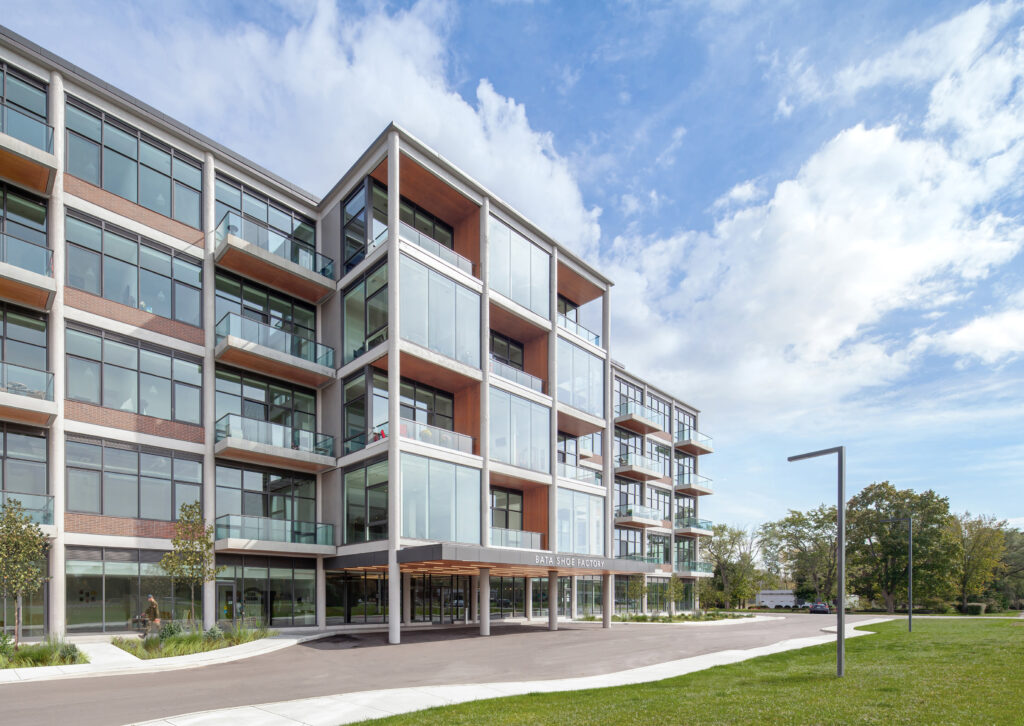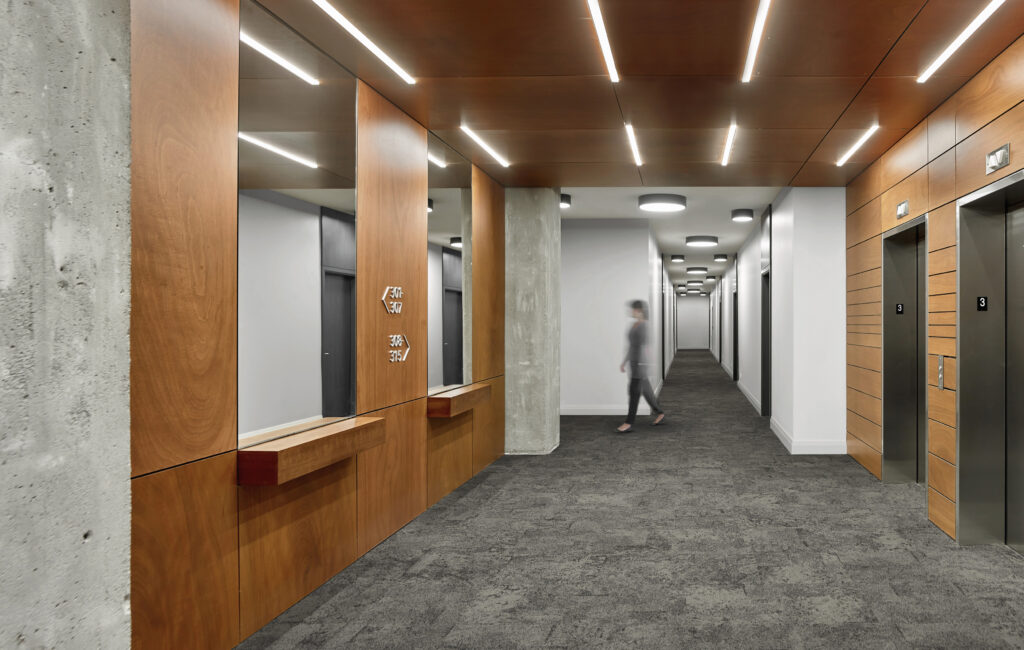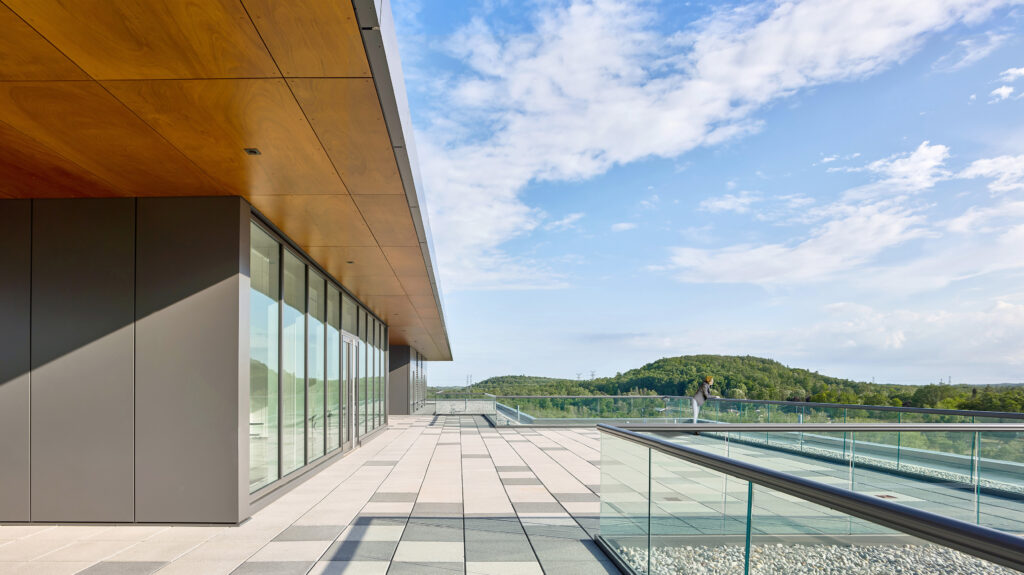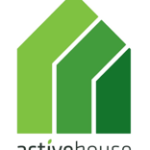031 Bata Shoe Factory
Location: Batawa, Ontario, Canada
Owner/investor: Batawa Development Corporation
Architects: BDP Quadrangle; Dubbeldam Architecture + Design
Project type: Renovation of a factory
Due to the long and narrow floorplate of the building, the residential units and other community spaces are not deep and are oriented toward the exterior. The exterior façade is comprised of ample fenestration as a reference to the original factory character of the building. With 13 foot high ceilings, natural light floods deep into the interior of every unit, producing an interior that is awash in natural light, reflecting off the white walls and bouncing further into the units, reducing the need for artificial lighting. The ample glazing also allows for views of nature and greenery outside, and the easily accessed exterior spaces such as generous balconies and the roof terrace with green roofs provide further biophilic connections to nature. All residential units as well as community and retail spaces on the ground and second floor are within 7m of an operable window. The operable windows in the upper floor residential units are located at a low height and draw in cool air, with warmer air exhausted through intake ducts near the ceiling, providing effective natural ventilation. Each unit has a sliding door opening onto a balcony to take advantage of cooling breezes.
The extensive geothermal energy system provides consistent thermal conditioning throughout the building, with tenants able to control their own units independently. The ventilation is optimized to keep CO2 levels down.

Among the key priorities that the client outlined for the project was the integration of sustainable and renewable energy systems. As a result, the client made a significant investment into geothermal technology to power the building’s heating and cooling systems. The installation of this geothermal system involved drilling 63 holes at a depth of 600 feet under the parking area, connected to and supplying 100% of the buildings HVAC needs. There is no natural gas utilized in the building, thereby reducing operating CO2 emissions to zero and ensuring it will respond well to potential future shortages and price increases of fossil fuels, as well as resulting in significant energy savings for both the building’s operators and its tenants. Electricity is consumed only for pumps, lighting and general occupant consumption (ie. appliances and electronics) ensuring even the hydro demand is well below average. High efficiency LED lighting is used throughout, with the actual energy consumption from Hydro bills being
5,95 kWh per annum. The EUI of the building calculated from a year’s worth of Hydro bills is 101.3 kWh/m2. The building envelope wall assembly is comprised of 125 mm continuous rigid insulation on the exterior and the cantilevered balconies are thermally broken, ensuring no thermal transfer through the structure. Both strategies significantly improve the effective R-value of the wall.

The adaptable reuse design strategy utilized in conjunction with an ongoing owner-management approach ensures the building will continue to service its new use for another 70+ years, preserving the embodied carbon and striving for new energy reduction goals. One of the most important takeaways from the LCA is that structural systems almost always comprise the largest source of embodied carbon in the building, so the first goal to reduce the embodied carbon was to target the structural system. With close to 80% of a building’s embodied carbon found in the existing structural components of the building and with concrete production alone representing an estimated 5% of global greenhouse emissions, retention of the building’s slabs, beams and columns was determined to yield the highest carbon emissions savings ratio. This strategy retained 5,200 m3 of concrete from the existing structure representing a savings of approximately 2 million kg of CO2 emissions and roughly 900 cement truck deliveries (avg 6m3 capacityper truckload). The retained concrete 20 ft x 20 ft grid, columns and large structural spans allow for flexibility of future use and allow the interior of the building to continue to be reconfigured and repurposed for generations to come.
The geothermal energy source will service the building well into the future and will limit the reliance of fossil fuels. The existing site was comprised of the factory building surrounded by a sea of concrete paving on three sides. All the concrete paving was removed and recycled for gravel, and a new parking area over the geothermal field with ample greenscaping was introduced. New building materials were selected for long life-spans, durability and eco-friendly characteristics right down to the carpet tiles made from recycled fishing nets and low VOC finishes. Millwork for kitchens and bathrooms were specifically selected for their low formaldehyde materials to ensure better interior air quality and occupant health. On the exterior, brick, aluminum-framed windows and Parklex wood veneer fibre-cement panels were utilized. The Parklex panels are EPD and FSC certified and are made of 10% recycled materials. The energy that Parklex uses to fabricate the panels comes from a 100%-renewable source. The wood panel
layouts were also studied to minimize the amount of off-cuts and material waste achieving an almost 10% reduction in waste.
Water conservation was a priority for this project as the town is fed from its own water supply and not municipal or township. Low flow plumbing fixtures (toilets, faucets and shower heads) were used throughout. Storm water management is handled primarily through a large bio swale that runs north-south along the west end of the site and captures and retains a significant amount of the site’s storm water while it gets absorbed into the earth. There is no permanent irrigation equipment needed for the facility’s green spaces, as the landscape includes native, drought-tolerant species that will not require irrigation once established. A significant portion of the roof is planted with a green roof which will not only serve to mitigate water run-off but also as improved insulation. The actual annual potable water consumption in the first year of occupancy was 28,384 L per occupant/annum. This translates to 3.46 L/m2/occupant/annum (taken from the building water bills).
On the social sustainability side, the project included a unique approach to community involvement. The design process for the revitalization of the factory building began with community, in the form of an inclusive consultation process, allowing local residents and other local stakeholders to have input in the factory redevelopment. Key to returning the building to its former foundation of purpose, the uses were specifically selected and balanced to enhance the character of the community and provide resources for locals. The space is now home to a daycare with an outdoor playground, an exhibition/community space, multi-purpose rooms for meetings or lectures, educational incubators, ground floor retail and café as well as other amenities open to both residents and community-at-large, including an accessible rooftop terrace. A rarity in rural areas, the building is equipped with hi-speed fibre internet service which opens opportunities for growing a local knowledge-based work economy and gives residents the option to work remotely rather than commute great distances to a workplace. As part of the initial community consultation, there was a notable amount of information sharing and education involved to help local residents and community stakeholders understand the short and long-term benefits of considering both a socially and environmentally sustainable strategy for this development. New tenants to the building receive an information package sharing the unique features and history of the building as well as best practices for a healthy building and healthy planet. The project has found both local and regional press eager to share its “down-to-earth-friendly” and community-oriented approaches with the goal of raising awareness.
To further enforce the idea of ‘community investment’, during the construction period the selected contractor utilized the services of as many local trades as possible, despite the difficulties of doing so. With a community-centred procurement focus, the project was designed to optimize the social and economic benefits for those living and working within a 100-mile radius of the site; it provides a reminder that successful community architecture is as much about process as it is about the final product. Last but certainly not least, the decision by the owner and operator to develop this project as an affordable rental model rather than a condominium shows further long-term commitment to fostering community.



